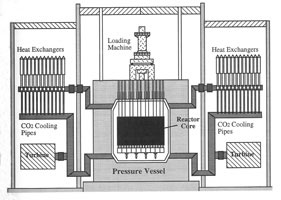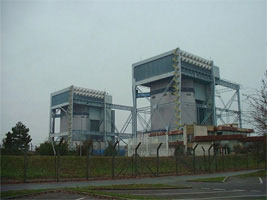The
name France is derived from the Frankish word frank
(Ger. frei) which means FREE as in: "Therefore if the Son makes you free, you shall be free indeed" (St. John 8:36). |
On Friday, Nov. 13, 2015, Paris had a mini Saint Bartholomew's Day Massacre with 130 people killed by "terrorists." Strangely enough, there were no funerals for any of the victims of the "terrorist" attack.
However, millions of French men, women, and children have been killed by the 59 nuclear power plants in the country. Radiation respects no borders so the deadly radiation was carried by the winds all over Europe.
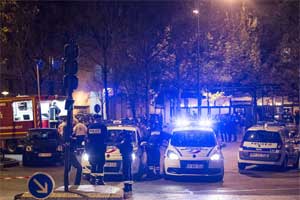 Chaos in radioactive Paris after the mini St. Bartholomew's Day Massacre. |
|
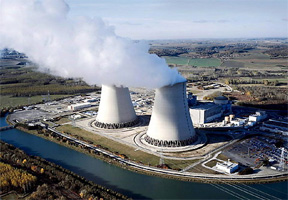 The Nogent-sur-Seine nuclear power plant just 96 km from Paris. |
The French have always been in the vanguard of the advancing hosts of civilization. John C. Frémont–whose father was French–was the man who pulled California out of the jaws of the British lion.
The mighty French Republic built the Suez Canal, and a Frenchman named Octave Chanute, along with Samuel Langley, were the pioneers of U.S. aviation.
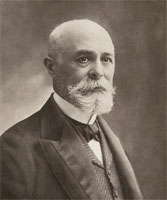 Antoine Henri Becquerel (1852–1908). |
|
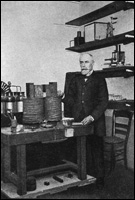 Antoine Henri Becquerel in his lab. |
Antoine Henri Becquerel was followed by 2 more imminent scientists named Pierre and Maria Curie.
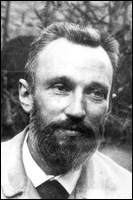 Pierre Curie (1859–1906). |
|
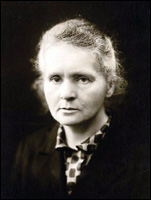 Marie Cure (1859–1934). |
In December 1898, the Curies announced the existence of a second element, which they named "radium," from the Latin word for "ray". In the course of their research, they also coined the word "radioactivity."
In April 1906, Pierre was killed in a road accident. Walking across the Rue Dauphine in heavy rain, he was struck by a horse-drawn vehicle and fell under its wheels, causing his skull to fracture.Curie was devastated by her husband's death. On May 13, 1906, the physics department of the University of Paris decided to retain the chair that had been created for Pierre and to offer it to Marie. She accepted it hoping to create a world-class laboratory as a tribute to Pierre. She was the first woman to become a professor at the University of Paris. She was not linked with the strange death of her husband.
The bombings in radioactive Paris killed hundreds but the 59 nuclear power plants in France have slowly killed MILLIONS over the last 60 years.
Most of the reactors in France use the pressurized water design (PWR) of admiral Hyman Rickover. Rickover's reactors were small compared to the giants in use today. Based on his design, the first commercial nuclear reactor was built in Shippingport, Pennsylvania, in 1958. By 1970, the deadly toll was evident. Here is a report by a professor from the University of Pittsburgh:
Knowing that it was a naval type of reactor with a double cooling loop to minimize the amount of gas that would have to be discharged into the atmosphere caused me to feel little concern, especially in view of the fact that the AEC had only recently announced that it was proposing to tighten up the standards for permissible emissions. (These new standards had been issued following hearings in Washington at which I had been asked to testify in behalf of various environmental groups on the need to lower permissible doses). (Sternglass, Secret Fallout: Low Level Radiation from Hiroshima to Three Mile Island, p. 140).
When the professor began to study the death statistics from the area surrounding Shippingport, he was alarmed:
My students and I started to examine the annual vital statistics reports for Beaver County, Allegheny County, and the major towns at different distances from Shippingport up and down the Ohio River. Within a few days the first results were tabulated, and the figures were startling. In the town of Midland, just a mile downstream from Shippingport, the people drank the Ohio River water. The cancer death rate in this town had risen from a low of 149.6 per hundred thousand population in 1958, when the plant started to operate, to a peak of 426.3 by 1970. This was an increase of 184 percent in only twelve years. (Sternglass, Secret Fallout: Low Level Radiation from Hiroshima to Three Mile Island, p. 147).
A nuclear power station exists for one reason: population reduction:
 Map of the Federal Republic of Germany. |
|
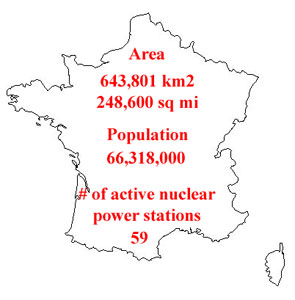 Map of the (radioactive) Republic of France. |
Doctors and statisticians were forced to stop gathering vital statistics on the deadly toll to humans, animals, birds, and plants from atomic radiation. Most of the research that was done in the United States was ruthlessly censored by the Pentagon.
After WWII, France decided that they must have nuclear weapons or be relegated to the status of a minor world power. The McMahon Act of 1946 completely restricted foreign access to U.S. nuclear technology. That Act was aimed mainly at the Soviets but the British and French were also included.
French nuclear physicists came up with a unique design for producing plutonium, called the gas-graphite reactor.
|
|
Uranium, even in its natural state, is the most toxic metal known to man. Uranium has been causing "cancer" since it was first mined in St. Joachimsthal in the 15th century.
However, enriched uranium, or U235, is far more deadlier. French reactors initially used natural uranium or U238 as the lesser of two evils.
France did not explode a hydrogen bomb until 1968
France exploded its first atomic bomb in the Sahara Desert, in 1960. Making an atomic bomb is child's play compared to making the "Super." France did not explode a hydrogen bomb until 1968. The reason for that was the lack of tritium, which is a vital ingredient in the "Super."
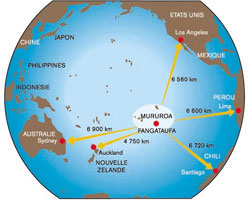 Fangataufa atoll in French Polynesia. |
|
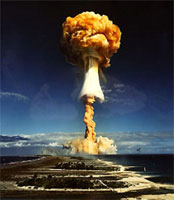 Mushroom cloud from the first French hydrogen bomb. |
In 1966, France was able to use fusion fuel to boost plutonium implosion devices with the Rigel shot. Roger Dautry, a nuclear physicist, was selected by the CEA to lead the development effort to construct a two-stage weapon. France did not have the ability to produce the materials needed for a two-stage thermonuclear device at the time, so 151 tons of heavy water was purchased from Norway and an additional 168 tons from the United States. This heavy water went into nuclear reactors in 1967 to produce tritium needed for the device.
The test made France the fourth country to test a thermonuclear device, after the United States, the Soviet Union, and China.
All of the original French designed reactors were phased out by 1969
As usual, the French showed great ingenuity in designing their nuclear reactors. They used natural uranium, which is not as deadly as enriched uranium.
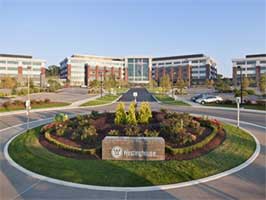 Westinghouse HQ in a suburb of Pittsburgh, Pennsylvania. |
|
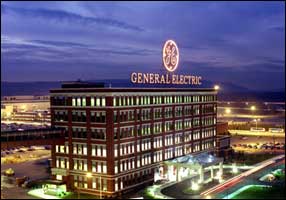 General Electric HQ in Fairfield, CT, is lit up by Tesla's AC. |
General Electric is the last conglomerate in the world to supply alternating current because they fought a ferocious battle against Tesla and Westinghouse to keep the entire world in the dark.
Most of the nuclear power plants in France are based on the General Electric or Westinghouse design. From 1885 to 1912, a bitter battle raged in the United States called the War of the Currrents. It pitted Thomas Edison and General Electric against Nikola Tesla and Westinghouse.
Tesla and Westinghouse won, but now Westinghouse is owned by their bitter rival, General Electric.
Vital Links
References
Hecht, Gabrielle, The Radiance of France: Nuclear Power and National Identity After World War II. MIT Press, Cambridge, MASS, 1998.
Sternglass, Ernerst. Secret Fallout: Low-Level Radiation from Hiroshima to Three-Mile Island. McGraw-Hill Book Company, New York, 1981.
Smith, Gar. Nuclear Roulette: The Truth about the Most Dangerous Energy Source on Earth. Chelsea Green Pub., White River Junction, Vermont, 2012.
Wasserman, Harvey, & Solomon, Norman. Killing our Own: The Disaster of America's Experience with Atomic Radiation. Delacorte Press, New York, 1982.
Copyright © 2015 by Patrick Scrivener
